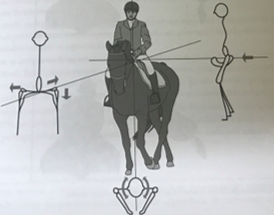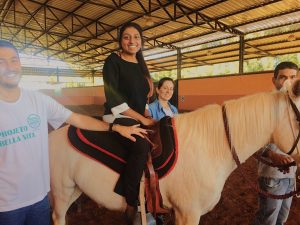10 months ago, Dr. Daniel proposed Project Bella Vita (meaning: Beautiful Life). Its three main components include the Prosthetic Factory, Equoterapia, and Rehabilitation.
Last week, Elisa and I had the opportunity to visit the Equoterapia farm. It is the only equoterapia in the world specifically for cancer patients. Associação Nacional de Equoterapia (ANDE) Brasil came up with the word “equoterapia”. This word encompasses all activities with the horse, particularly activities aimed at rehabilitation. Equoterapia is a therapeutic method that allows individuals to be in contact with the horse and promotes the development of an individual on a biopsychosocial level. Riding on the horse imitates the cadence of human steps, so it allows paralyzed individuals or individuals with difficulty walking to experience what it feels like to walk, and eventually, through proper training, be able to walk with little to no support from others. Equoterapia can also be used for patients with prosthetics for them to slowly get accustomed to their prosthetic. Equoterapia, essentially, is beneficial to a variety of patients.
The interdisciplinary team at Project Bella Vita, composed of the equo team, physiotherapists, neuropsychologists, orthopedics and pediatricians, comes together to provide proper care and discuss plans of care for its patients.
The concept behind this therapy is quite ancient – it dates back to the year 458.
Year 458: This is when a research study stated that riding was recommended to regenerate health, prevent diseases, treat insomnia, and improve tone.
Later on, in 1747, Dr. Samuel T. Quelmalz, a physician, wrote a book called Health through Horse Riding that highlights the benefits of the movement of the horse’s back.
In 1917, The University Hospital of Oxford founded the first equoterapia unit that attended the wounded of World War I.
In 1954, the first interdisciplinary team for equine therapy was established in Norway. It was eventually brought to Brazil with physiotherapist Gabriele Brigitte Walter.
In 1984, Dr. Detlvev Rieder claimed that riding a horse produces enough number of vibrations to stimulate the sympathetic nervous system.
In 1989, ANDE-Brasil was created.
The horse averages 82 steps per minute. In this minute, it generates:
- 246 three-dimensional undulations (wave-like motion)
- 738 postural corrections in the patient
- 1,447 activations of muscle groups (in fact, this is the only activity that moves all the muscles of the body and all joints)
A thirty-minute session with the horse results in 354,240 muscle contractions.
In addition, equoterapia develops psychomotor behaviors like:
- Body layout
- Perception
- Balance
- Motor coordination
- Spatial and temporal strength
Equoterapia teaches positive thought processes such as helping, accepting being helped, accepting one’s limitations, and respecting the limitations of others. Within simply four weeks, you can see significant improvement in the patient’s health. Equoterapia, as a component of Project Bella Vita, has a lot of potential for treating certain cancer patients in an alternative manner.


